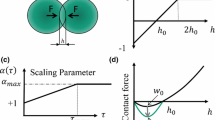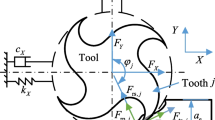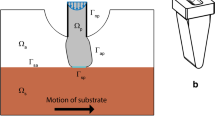Abstract
In electronics manufacturing the time-pressure dispensing system has been widely used to squeeze adhesive fluid in a syringe onto boards or substrates with pressurised air. For accurate control of the fluid volume, it is vital to have a thorough understanding of the whole process. However, the complexity of the process, which includes air-fluid coupling and their nonlinear uncertainties, makes it difficult to obtain an accurate process model. Using the spectral method, an approximate fluid flow model for both the Newtonian and non-Newtonian fluid can be developed. By taking into account nonlinear flow passing through the valve, attenuation and time delay in the pneumatic lines, syringe chamber dynamics and fluid flow dynamics, a simple but effective model is derived to describe the whole dispensing system with reasonable accuracy. Experiments performed thereafter validate the model.
Similar content being viewed by others
References
Bush R (1997) Matching fluid dispensers to materials for electronics Applications. Electron Packag Prod 37(9)6–62
Razban A (1993) Intelligent control of an automated adhesive dispensing Cell. PhD Thesis, Imperial College, London, UK
Razban A, Davies BL, Harris S, Efstathiou J (1995) Control of an automated dispensing cell with vision controlled feedback. Control Eng Pract 3(9):1217–1223
Chen XB, Schoenau G, Zhang WJ (2001) Dynamic modeling of the flow rate in time-pressure fluid dispensing processes. Proceedings of IPACK’01, Hawaii
Richer E, Hurmuzlu Y (2000) A high performance pneumatic force actuator system part 1 – nonlinear mathematical model. ASME J Dyn Syst Meas Control 122(3):416–425
Schuder CB, Binder RC (1959) the response of pneumatic transmission lines to step inputs. J Basic Eng 81:578–584
Kien F (1989) Theory of pseudoplastic screen inks in orifice printing. IEEE Trans Compon Packag Manuf Technol 112(2):254–258
Skelland AHP (1967) Non-newtonian flow and heat transfer. Wiley, New York
Boyd JP (2000) Chebyshev and Fourier spectral methods, 2nd edn. Dover, New York
Nanjing University mathematic department (1995) Special function for mathematical and physical equation, 2nd edn. Higher Education Press, Beijing
Hong YP, Li HX (2003) Comparative Study of Fluid Dispensing Modelling. IEEE Trans Electron Packag Manuf 26(4):273–280
Li HX, Tso SK, Deng H (2001) A conceptual approach to integrate design and control for epoxy dispenser. Int J Adv Manuf Technol l17:677–682
Author information
Authors and Affiliations
Corresponding author
Rights and permissions
About this article
Cite this article
Zhao, YX., Li, HX., Ding, H. et al. Integrated modelling of a time-pressure fluid dispensing system for electronics manufacturing. Int J Adv Manuf Technol 26, 1–9 (2005). https://doi.org/10.1007/s00170-003-1978-2
Received:
Accepted:
Published:
Issue Date:
DOI: https://doi.org/10.1007/s00170-003-1978-2




